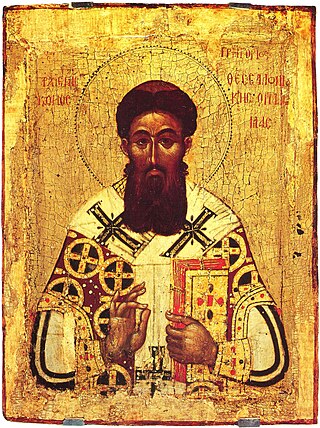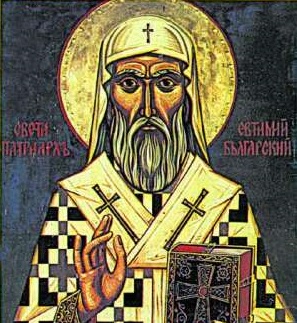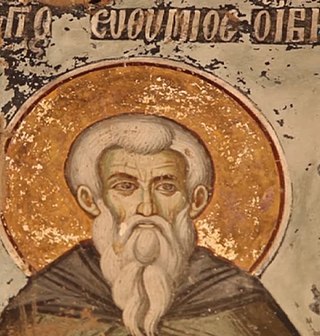Related Research Articles

Gregory Palamas was a Byzantine Greek theologian and Eastern Orthodox cleric of the late Byzantine period. A monk of Mount Athos and later archbishop of Thessalonica, he is famous for his defense of hesychast spirituality, the uncreated character of the light of the Transfiguration, and the distinction between God's essence and energies. His teaching unfolded over the course of three major controversies, (1) with the Italo-Greek Barlaam between 1336 and 1341, (2) with the monk Gregory Akindynos between 1341 and 1347, and (3) with the philosopher Gregoras, from 1348 to 1355. His theological contributions are sometimes referred to as Palamism, and his followers as Palamites.

Nicholas Kabasilas or Cabasilas was a Byzantine mystic and theological writer.

Saint Euthymius of Tarnovo was Patriarch of Bulgaria between 1375 and 1393. Regarded as one of the most important figures of medieval Bulgaria, Euthymius was the last head of the Bulgarian Orthodox Church in the Second Bulgarian Empire. Arguably the best esteemed of all Bulgarian patriarchs, Euthymius was a supporter of hesychasm and an authoritative figure in the Eastern Orthodox world of the time.
Callistus I of Constantinople was the Ecumenical Patriarch of Constantinople for two periods from June 1350 to 1353 and from 1354 to 1363. Callistus I was an Athonite monk and supporter of Gregory Palamas. He died in Constantinople in August 1363.

Athanasius the Athonite, was a Byzantine monk who is considered the founder of the monastic community on the peninsula of Mount Athos, which has since evolved into the greatest centre of Eastern Orthodox monasticism.

Euthymius the Athonite was a Georgian monk, philosopher and scholar, who is venerated as a saint. His feast day in the Orthodox Church is May 13.
A typikon is a liturgical book which contains instructions about the order of the Byzantine Rite office and variable hymns of the Divine Liturgy.

Euthymius I of Constantinople was the Ecumenical Patriarch of Constantinople from February 907 to 15 May 912. A monk since his youth, he became spiritual father of the future emperor Leo VI the Wise, and was raised by him to the high ecclesiastical office of syncellus. Despite his turbulent relationship with Leo VI, in 907 he was appointed to the patriarchate and held the post until his deposition shortly before or after Leo VI's death in 912.
Stylianos Zaoutzes was a high Byzantine official of Armenian origin. Rising to high rank under Byzantine emperor Basil I, he then rose further to prominence under Basil's successor Emperor Leo VI the Wise, who had a close friendship and possibly an affair with Stylianos's daughter Zoe Zaoutzaina. Stylianos Zaoutzes was Leo's leading minister during the first half of his reign, and was awarded the unique title of basileopator. His standing and influence declined after 895, but in 898, he became Leo's father-in-law when the Byzantine emperor married Zoe. He died in 899, in the same year as Zoe. Following an attempted coup by his relatives, the Zaoutzes clan was deprived of the considerable power it had amassed under Stylianos's tutelage.
Euthymius or Euthymios may refer to:
Maximos of Kafsokalyvia or Maximos Kausokalybis, also known as St. Maximos the Hut Burner, was a hesychast monk who lived on Mount Athos in Greece. Some of Maximos' writings on prayer and ascetism are included in the Philokalia.
Niphon Kausokalybites was a Greek Orthodox Christian saint and monk. He is celebrated by the Eastern Orthodox Church on June 14.

Saint Elias of Enna, born John Rachites, is venerated as a saint by the Catholic Church and the Orthodox Church. Elias is also known as Saint Elias the Younger, or Junior, to distinguish him from the biblical prophet Elijah. He lived a very adventurous life during the ninth century and was the protagonist of repeated exploits. He is commemorated on August 17.

Euthymius of Sardis or Euthymius the Confessor was metropolitan bishop of Sardis between ca. 785 and ca. 804, and a leading iconophile during the period of Byzantine Iconoclasm. Martyred in 831, he is a saint in the Eastern Orthodox Church, celebrated on 26 December and March 8.

The monastic community of Mount Athos is an Eastern Orthodox community of monks around Mount Athos, Greece, who hold the status of an autonomous region with its own sovereignty within Greece and the European Union, as well as the combined rights of a decentralized administration, a region, a regional unit and a municipality, with a territory encompassing the distal part of the Athos peninsula including Mount Athos. The bordering proximal part of the peninsula belongs to the regular Aristotelis community in Central Macedonia.
Hilarion the Iberian was a Georgian monk from the Kakheti region, bishop of David Gareja. He was considered as the thaumaturgus and is venerated as a saint. His vita was composed after his death on Mount Athos by the followers of Euthymius of Athos. The extant texts are from 10th and 11th centuries. Per the vita, Hilarion visited the Holy Land and traveled with his followers through Palestine and Syria. He visited Mount Tabor, the Jordan River and the Lavra of Saint Sabas. Hilarion would stay there for seven years living in the cave leading monastic hermitage. Later, in 864, he founded a monastery on Mount Olympus, possibly identified as "Lavra of Krania", which was housing largely his Georgian compatriots. The church at various times sheltered John the Iberian, Euthymius of Athos and Tornike Eristavi. Hilarion died in Thessaloniki.

Kerasia is a settlement in Mount Athos. It is located at an elevation of 581 metres on the southwestern slopes of the main peak of Mount Athos. Located just to the east of Little St. Anne's Skete and Katounakia, it is inhabited by a few dozen monks.
Saint Acacius or Akakios the Younger, also known as Akakios the New of Kafsokalyvia was a Greek Orthodox Christian monk and ascetic who lived on Mount Athos. His feast day is celebrated by the Eastern Orthodox Church on April 12.

Kafsokalyvia is a settlement and idiorrhythmic skete located on Mount Athos. It is located at the southern edge of the Athos peninsula. Kafsokalyvia is named after Maximos Kausokalybites, a 14th-century Christian hermit.

The Desert of Mount Athos or Wilderness of Mount Athos is a geographical area of Mount Athos that corresponds to the southern slopes of Mount Athos. Located along the southernmost coast of the Athos peninsula, it stretches roughly from Katounakia in the west to Vigla in the east. The Desert of Mount Athos has been a center of Christian asceticism and hesychasm for over 1,000 years.
References
- 1 2 Kazhdan, Alexander P., ed. (2005). "Euthymios the Younger". The Oxford Dictionary of Byzantium. doi:10.1093/acref/9780195046526.001.0001. ISBN 978-0-19-504652-6 . Retrieved 15 March 2017.
also called Euthymios of Thessalonike, saint; baptismal name Niketas; born village of Opso, Galatia 823/4
- 1 2 "St. Euthymius the Younger — Saints & Angels". Catholic Online. 2023-10-04. Retrieved 2023-10-18.
- ↑ Greenfield, Richard P. H.; Talbot, Alice-Mary Maffry (2016). Holy Men of Mount Athos. Dumbarton Oaks Medieval Library. Vol. 40. Cambridge, Massachusetts: Harvard University Press. ISBN 978-0-674-08876-4.